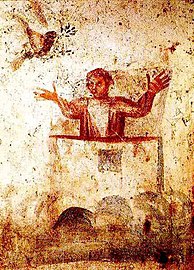Peristerium

A peristerium (from Greek περιστερά peristera , German 'dove' ), also called columba , host dove or eucharistic dove , is a ciborium in the shape of a dove that is used to store the holy of holies .
history
The peristerium is a gold or silver container that was used in medieval churches to store the Eucharistic bread. The consecrated hosts were in a pyxis that could be inserted through a flap in the back of the dove.
A first reference to dove-shaped containers for hosts can be found in a writing by Tertullian . Corresponding containers are also mentioned in the vites of the church father Basilius and St. Innocent I and in the Liber Pontificalis of Pope New Year's Eve (314–335). The peristeria experienced a heyday from the 11th to the end of the 13th century, until they were in 14/15. Century were replaced by the sacraments as the repository of the Blessed Sacrament. The dove and other receptacles for the host were usually hung floating above the altar.
Host pigeons from Limoges
Host doves with inlays made of enamel were a specialty of the goldsmiths of Limoges , which had developed into an outstanding center for enamel art in the 12th century. The liturgical vessels made there were widespread throughout Europe, which was also helped by the city's location on the Way of St. James . The copper pigeons were provided with a trough with a lid in which the hosts could be stored, as well as with devices that allowed the pigeons to be hung. They have been manufactured since the turn of the 12th century, and a strong boom in production began in the course of the 13th century. As a rule, the gilded pigeons had inlays made of pit enamel on the tail, wings and footplates in the typical Limoges colors of white, blue and green, occasionally also with additions of red and yellow, in individual copies gemstones are fitted to the transverse bands of the wings.
Dove as a religious symbol
In the Old Testament , the dove indicated the end of the flood . As a sacrificial animal of the poor, it is already mentioned in the covenant sacrifice of Abraham ( Gen 15.9 EU ). Pigeons were kept as sacrificial animals in the forecourt of the temple and could be purchased there ( Mt 21.12 EU , Mk 11.15 EU , Joh 2.14-16 EU ). Such a pair of pigeons also sacrificed Mary and Joseph during the cleansing sacrifice after the birth of Jesus .
In the New Testament and in Christian iconography, the dove symbolizes the Holy Spirit ( Mt 3:16 EU ). As a symbol of resurrection pigeons were in the graves of the martyrs placed and grave lights in the form of pigeons were common.
Sarcophagus from the 3rd century AD, with the monogram of Christ and a dove
literature
- Joseph Braun SJ: The Christian Altar . Vol. 2, Munich 1924, pp. 599-605.
- Bonaparte: Iconography of the pigeon . Paris 1857.
- Waiter pigeon . In: Specialized dictionary on the art of the Middle Ages. Zurich 1996, ISBN 3-7630-2332-1 , p. 181.
- Peter Lang: Medieval enamel work from Limoges . Riggisberg 2011.
Individual evidence
- ↑ Nostrae columbae etiam domus simplex, in editis semper et apertis et ad lucem. Amat figura Spiritus Sancti Orientem, Chriti figuram Tertullian. Liber Adversus Valentinianos. PLM 11, col. 545.
- ↑ Rafael Gonzalez Fernández: La paloma y su simbolismo en la patrologia latina . In: Antigüe y Christianismo 16, 1999, p. 194.
- ↑ J. Braun: The Christian altar . Vol. 2, pp. 599-605.


